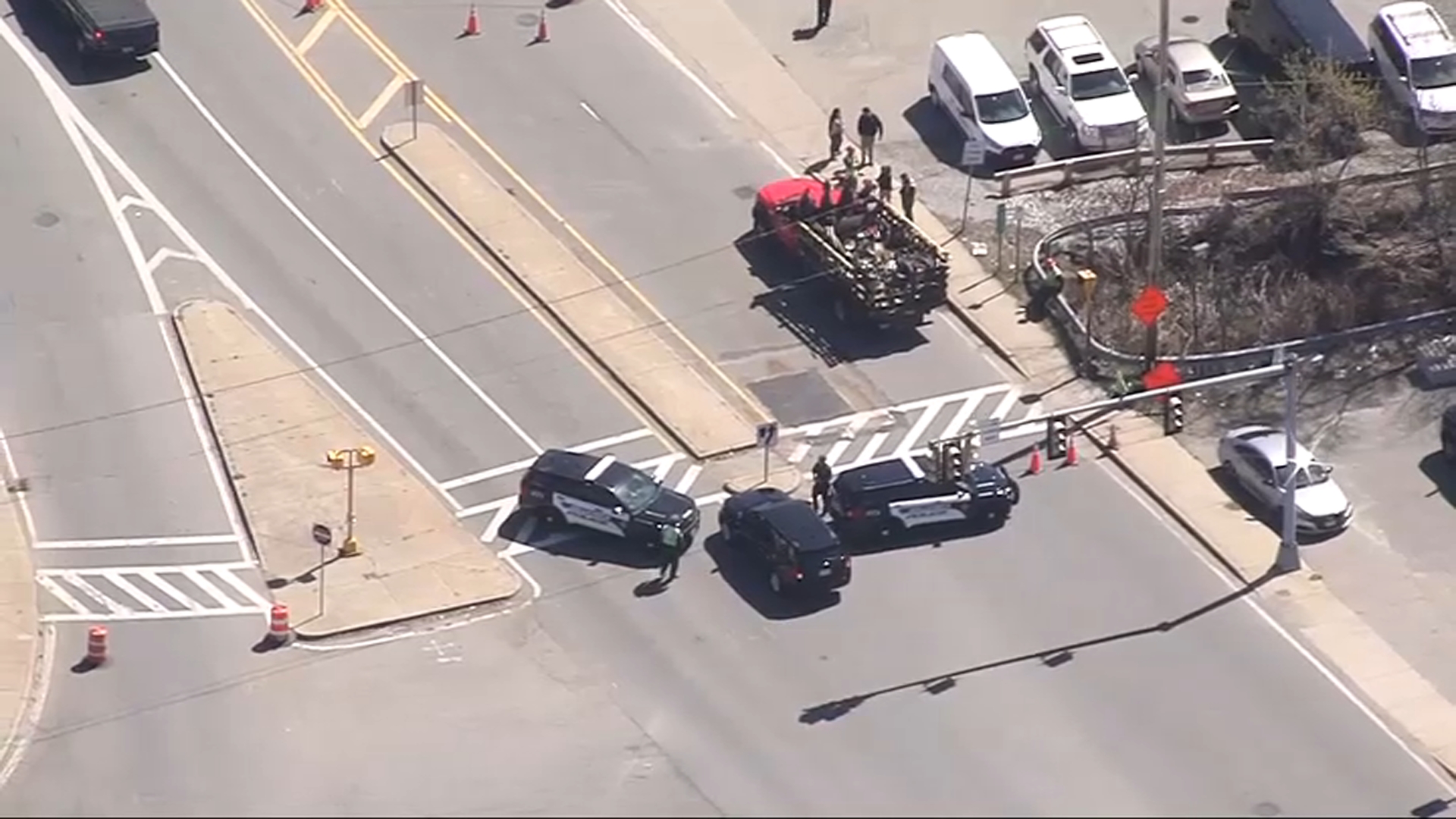A Billerica police officer was hospitalized after being exposed to fentanyl during a traffic stop, according to the police department.
Wednesday afternoon the officer stopped a vehicle with a canceled registration. According to the police report, the officer observed the driver ripping open and dumping a bag of heroin.
“Obviously that is evidence and the officer attempted to stop him from doing that,” said Billerica Police Chief Roy Frost. “It’s a very tight and enclosed area in the front of the car and this product went airborne and while it was airborne this officer ultimately ingested or inhaled some of this powder is what we believe likely caused the medical episode that she suffered shortly thereafter.”
Frost said the driver was arrested and transported to the police station for booking and the officer was standing in the hallway outside of the booking area when she became ill.
Get Boston local news, weather forecasts, lifestyle and entertainment stories to your inbox. Sign up for NBC Boston’s newsletters.
“She appeared lethargic and as the officer was dealing with the defendant at the booking area she dropped and her eyes rolled back in the back of her head, she became unresponsive, she started to vomit,” said Frost. “What caused that medical episode, it’s probable that it was the inhalation of whatever this substance was which was later tested as positive for fentanyl.”
He said paramedics at the station provided initial treatment and then the officer was transported to a hospital.
“This incident illustrates the danger posed by even a small amount of fentanyl that became airborne,” Frost said in a press release published Friday. “We are grateful that our officer is expected to make a full recovery, but alarmed that such a small amount of fentanyl caused an officer to lose consciousness. This incident highlights the potency of fentanyl and the dangers that are faced by officers if this substance becomes airborne.”
Local
In-depth news coverage of the Greater Boston Area.
The driver was charged with withholding evidence from a criminal proceeding, possession of a class A substance, possession of a class E substance, operating with a suspended license, attaching plates, operating an unregistered motor vehicle, and operating an uninsured motor vehicle.
There have been numerous reports in recent years of first responders “overdosing” after coming in contact with unknown powdered substances.
“We've all seen those sort of imageries of you know, a grain of fentanyl for someone who's opioid naive is enough to cause an overdose. But that sort of information is really if you ingest fentanyl,” said Dr. Sarah Wakeman, an addiction medicine physician and medical director for substance use disorder at Mass General Brigham.
She is among medical experts who say many of these accounts are unconfirmed and spread misinformation about the effects of opioids.
“Often people report feeling dizzy or faint, and then they sort of have a fainting spell or what we would call syncope or lose consciousness briefly. And lots of different things can cause those things,” said Wakeman. Thankfully, none of those are really symptoms of an opioid-related overdose where classically, you'd see someone's breathing slow down and then stop. So it's really respiratory depression that drives an opioid overdose. That's what ultimately kills you, is lack of oxygen.”
“To experience symptoms of overdose or other symptoms or symptoms of opioid toxicity, you have to ingest a substantial amount of fentanyl through some form of contact with your mucous membranes, which means basically snorting it or eating it or ingesting it through, perhaps other orifices in your body. The risk of overdose from casual contact, whether by breathing or by touching it is extremely low. And pretty much is a medical impossibility,” said Leo Beletsky, professor of Law and Health Sciences and Faculty Director of the Action Lab at the Center for Health Policy and Law at Northeastern University.
In 2020, he coauthored a study on “fentanyl panic” and the spread of misinformation about overdose risk from casual contact with fentanyl in mainstream and social media.
“We found that these stories really to go viral. They are sensational. They're scary. I think they attract and capture people's attention,” said Beletsky.
“This is something that unfortunately, was facilitated by our flagship Drug Enforcement Agency, the DEA, which in 2016 put out an official statement, essentially supporting this myth. And so when the federal agency responsible for drug law enforcement has information online, that is essentially inaccurate, and repeats unfounded information. It's very hard to combat misinformation in this in this context, because a lot of news agencies or just people out there rightly will point to that communique and say, well, the DEA says this can happen, how can you tell me that it can't? Thankfully, since, the DEA has corrected some of the online material that they have on this, but in many cases the cat is out of the bag and once something has gathered momentum, it often is very difficult to correct.”
The American College of Medical Toxicology (ACMT) and American Academy of Clinical Toxicology (AACT) published a position paper in 2017 that acknowledged fentanyl and its analogs are potent opioid receptor agonists, but the risk of clinically significant exposure to emergency responders is extremely low.
Why would first responders experience “medical episodes” when exposed to fentanyl?
“In many of these events that have transpired beforehand a lot of times the symptoms are really consistent more with a panic attack which is fed by misinformation about fentanyl,” said Beletsky.”The more rumors and myths there are out there about fentanyl exposure causing overdose in these kinds of casual encounters, the more stressed out and anxious our first responders are and I think it's really unfortunate that instead of correcting these myths, a lot of media outlets and a lot of law enforcement agencies have instead proliferated it.”
“I think there is some element of stress and then people may get sick for other reasons or maybe other things going on and a natural inclination might be to think this could be because of fentanyl exposure,” said Wakeman. “And I think, you know now seeing a handful of these cases that get a lot of attention and then unfortunately, that spreads. This fear that makes people's jobs even scarier than they need to be. I know. We know that our first responders are dealing with really stressful situations and thankfully, unintentional fentanyl overdose doesn't seem to be something that they need to be worried about.”
Frost acknowledged the controversy over these types of accounts.
“It’s possible this officer’s medical episode was related to something other than fentanyl, it’s absolutely possible, it’s not probable though that the exposure is not what caused her medical episode she was healthy and then she wasn’t and she was exposed to a clandestinely made unknown narcotic that caused a problem for her and so it’s dangerous.”
Frost said the substance would be sent for further testing at a state drug lab. The officer was released from the hospital and is expected to return to work next week.
Know the signs of an overdose
“I think the important takeaway is for the public to know about fentanyl is that although it's a scary substance for someone who's using drugs, and it's important to know it can be cross-contaminated and non-opioid drugs including things like cocaine or methamphetamine, a fentanyl overdose is entirely reversible with a medication called Naloxone that is now over the counter and that's something that we can all carry with us. It can be in every medicine cabinet. We can all save a life by administering a simple nasal spray in the setting of an opioid overdose,” said Dr. Wakeman.
“The symptoms of that would be slow or stopped breathing, which then leads to blue lips looking sort of blue or dusky skin and not responding and you would want to get someone Naloxone and call for help.”
Get updates on what's happening in Boston to your inbox. Sign up for our News Headlines newsletter.



